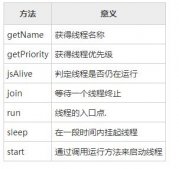接着上一篇再为大家介绍java应用和输入输出常用方法,供大家参考,具体内容如下
一、应用
1、使用StringBuilder或StringBuffer
|
1
2
3
4
5
6
7
8
9
10
11
12
13
14
15
16
17
18
19
20
21
|
// join(["a", "b", "c"]) -> "a and b and c"String join(List<String> strs) { StringBuilder sb = new StringBuilder(); boolean first = true; for (String s : strs) { if (first) first = false; else sb.append(" and "); sb.append(s); } return sb.toString();} |
- 不要像这样使用重复的字符串连接:s += item ,因为它的时间效率是O(n^2)。
- 使用StringBuilder或者StringBuffer时,可以使用append()方法添加文本和使用toString()方法去获取连接起来的整个文本。
- 优先使用StringBuilder,因为它更快。StringBuffer的所有方法都是同步的,而你通常不需要同步的方法。
2、生成一个范围内的随机整数
|
1
2
3
4
5
6
7
8
9
10
11
|
Random rand = new Random(); // Between 1 and 6, inclusiveint diceRoll() { return rand.nextInt(6) + 1;} |
- 总是使用Java API方法去生成一个整数范围内的随机数。
- 不要试图去使用 Math.abs(rand.nextInt()) % n 这些不确定的用法,因为它的结果是有偏差的。此外,它的结果值有可能是负数,比如当rand.nextInt() == Integer.MIN_VALUE时就会如此。
3、使用Iterator.remove()
|
1
2
3
4
5
6
7
8
9
10
11
12
13
|
void filter(List<String> list) { for (Iterator<String> iter = list.iterator(); iter.hasNext(); ) { String item = iter.next(); if (...) iter.remove(); }} |
remove()方法作用在next()方法最近返回的条目上。每个条目只能使用一次remove()方法。
4、返转字符串
|
1
2
3
4
5
|
String reverse(String s) { return new StringBuilder(s).reverse().toString();} |
这个方法可能应该加入Java标准库。
5、启动一条线程
下面的三个例子使用了不同的方式完成了同样的事情。
实现Runnnable的方式:
|
1
2
3
4
5
6
7
8
9
10
11
12
13
14
15
16
17
|
void startAThread0() { new Thread(new MyRunnable()).start();} class MyRunnable implements Runnable { public void run() { ... }} |
继承Thread的方式:
|
1
2
3
4
5
6
7
8
9
10
11
12
13
14
15
16
17
|
void startAThread1() { new MyThread().start();} class MyThread extends Thread { public void run() { ... }} |
匿名继承Thread的方式:
|
1
2
3
4
5
6
7
8
9
10
11
12
13
|
void startAThread2() { new Thread() { public void run() { ... } }.start();} |
不要直接调用run()方法。总是调用Thread.start()方法,这个方法会创建一条新的线程并使新建的线程调用run()。
6、使用try-finally
I/O流例子:
|
1
2
3
4
5
6
7
8
9
10
11
12
13
14
15
|
void writeStuff() throws IOException { OutputStream out = new FileOutputStream(...); try { out.write(...); } finally { out.close(); }} |
锁例子:
|
1
2
3
4
5
6
7
8
9
10
11
12
13
14
15
|
void doWithLock(Lock lock) { lock.acquire(); try { ... } finally { lock.release(); }} |
- 如果try之前的语句运行失败并且抛出异常,那么finally语句块就不会执行。但无论怎样,在这个例子里不用担心资源的释放。
- 如果try语句块里面的语句抛出异常,那么程序的运行就会跳到finally语句块里执行尽可能多的语句,然后跳出这个方法(除非这个方法还有另一个外围的finally语句块)。
二、输入/输出
1、从输入流里读取字节数据
|
1
2
3
4
5
6
7
8
9
10
11
12
13
14
15
16
17
18
19
20
21
|
InputStream in = (...);try { while (true) { int b = in.read(); if (b == -1) break; (... process b ...) }} finally { in.close();} |
read()方法要么返回下一次从流里读取的字节数(0到255,包括0和255),要么在达到流的末端时返回-1。
2、从输入流里读取块数据
|
1
2
3
4
5
6
7
8
9
10
11
12
13
14
15
16
17
18
19
20
21
22
23
|
InputStream in = (...);try { byte[] buf = new byte[100]; while (true) { int n = in.read(buf); if (n == -1) break; (... process buf with offset=0 and length=n ...) }} finally { in.close();} |
要记住的是,read()方法不一定会填满整个buf,所以你必须在处理逻辑中考虑返回的长度。
3、从文件里读取文本
|
1
2
3
4
5
6
7
8
9
10
11
12
13
14
15
16
17
18
19
20
21
22
23
|
BufferedReader in = new BufferedReader( new InputStreamReader(new FileInputStream(...), "UTF-8"));try { while (true) { String line = in.readLine(); if (line == null) break; (... process line ...) }} finally { in.close();} |
- BufferedReader对象的创建显得很冗长。这是因为Java把字节和字符当成两个不同的概念来看待(这与C语言不同)。
- 你可以使用任何类型的InputStream来代替FileInputStream,比如socket。
- 当达到流的末端时,BufferedReader.readLine()会返回null。
- 要一次读取一个字符,使用Reader.read()方法。
- 你可以使用其他的字符编码而不使用UTF-8,但最好不要这样做。
4、向文件里写文本
|
1
2
3
4
5
6
7
8
9
10
11
12
13
14
15
16
17
|
PrintWriter out = new PrintWriter( new OutputStreamWriter(new FileOutputStream(...), "UTF-8"));try { out.print("Hello "); out.print(42); out.println(" world!");} finally { out.close();} |
- Printwriter对象的创建显得很冗长。这是因为Java把字节和字符当成两个不同的概念来看待(这与C语言不同)。
- 就像System.out,你可以使用print()和println()打印多种类型的值。
- 你可以使用其他的字符编码而不使用UTF-8,但最好不要这样做。
以上就是本文的全部内容,希望对大家的学习有所帮助。












